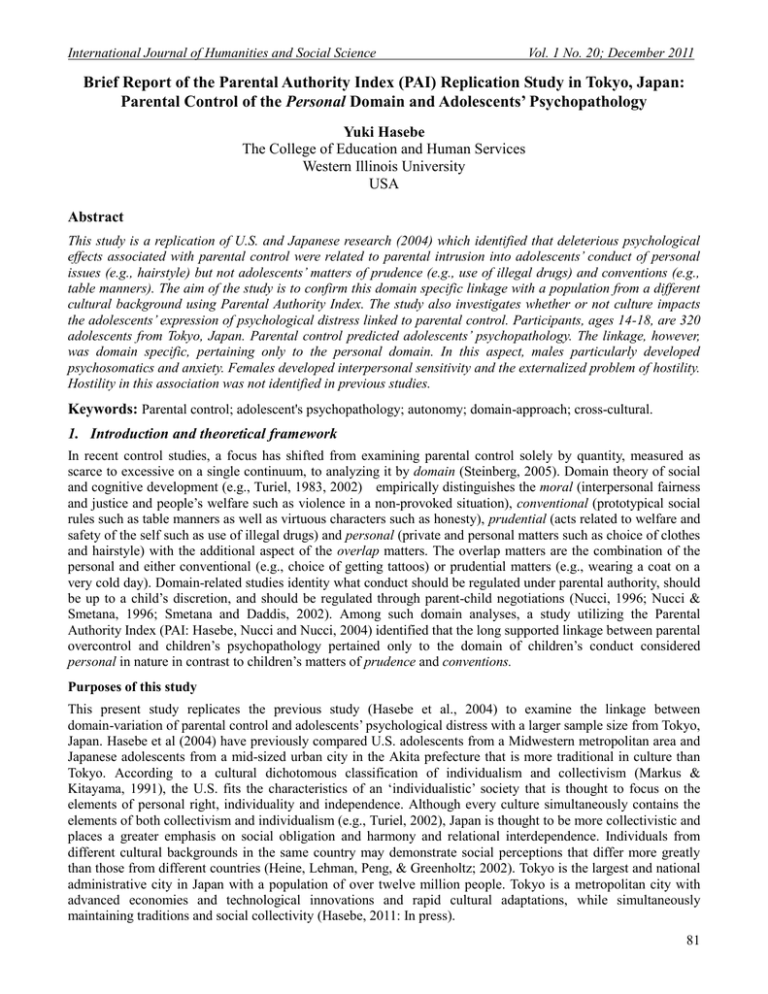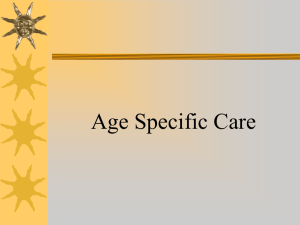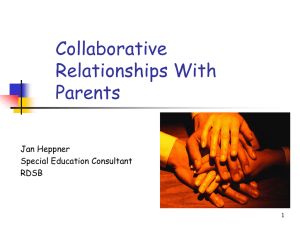Document 10467021
advertisement

International Journal of Humanities and Social Science Vol. 1 No. 20; December 2011 Brief Report of the Parental Authority Index (PAI) Replication Study in Tokyo, Japan: Parental Control of the Personal Domain and Adolescents’ Psychopathology Yuki Hasebe The College of Education and Human Services Western Illinois University USA Abstract This study is a replication of U.S. and Japanese research (2004) which identified that deleterious psychological effects associated with parental control were related to parental intrusion into adolescents’ conduct of personal issues (e.g., hairstyle) but not adolescents’ matters of prudence (e.g., use of illegal drugs) and conventions (e.g., table manners). The aim of the study is to confirm this domain specific linkage with a population from a different cultural background using Parental Authority Index. The study also investigates whether or not culture impacts the adolescents’ expression of psychological distress linked to parental control. Participants, ages 14-18, are 320 adolescents from Tokyo, Japan. Parental control predicted adolescents’ psychopathology. The linkage, however, was domain specific, pertaining only to the personal domain. In this aspect, males particularly developed psychosomatics and anxiety. Females developed interpersonal sensitivity and the externalized problem of hostility. Hostility in this association was not identified in previous studies. Keywords: Parental control; adolescent's psychopathology; autonomy; domain-approach; cross-cultural. 1. Introduction and theoretical framework In recent control studies, a focus has shifted from examining parental control solely by quantity, measured as scarce to excessive on a single continuum, to analyzing it by domain (Steinberg, 2005). Domain theory of social and cognitive development (e.g., Turiel, 1983, 2002) empirically distinguishes the moral (interpersonal fairness and justice and people‟s welfare such as violence in a non-provoked situation), conventional (prototypical social rules such as table manners as well as virtuous characters such as honesty), prudential (acts related to welfare and safety of the self such as use of illegal drugs) and personal (private and personal matters such as choice of clothes and hairstyle) with the additional aspect of the overlap matters. The overlap matters are the combination of the personal and either conventional (e.g., choice of getting tattoos) or prudential matters (e.g., wearing a coat on a very cold day). Domain-related studies identity what conduct should be regulated under parental authority, should be up to a child‟s discretion, and should be regulated through parent-child negotiations (Nucci, 1996; Nucci & Smetana, 1996; Smetana and Daddis, 2002). Among such domain analyses, a study utilizing the Parental Authority Index (PAI: Hasebe, Nucci and Nucci, 2004) identified that the long supported linkage between parental overcontrol and children‟s psychopathology pertained only to the domain of children‟s conduct considered personal in nature in contrast to children‟s matters of prudence and conventions. Purposes of this study This present study replicates the previous study (Hasebe et al., 2004) to examine the linkage between domain-variation of parental control and adolescents‟ psychological distress with a larger sample size from Tokyo, Japan. Hasebe et al (2004) have previously compared U.S. adolescents from a Midwestern metropolitan area and Japanese adolescents from a mid-sized urban city in the Akita prefecture that is more traditional in culture than Tokyo. According to a cultural dichotomous classification of individualism and collectivism (Markus & Kitayama, 1991), the U.S. fits the characteristics of an „individualistic‟ society that is thought to focus on the elements of personal right, individuality and independence. Although every culture simultaneously contains the elements of both collectivism and individualism (e.g., Turiel, 2002), Japan is thought to be more collectivistic and places a greater emphasis on social obligation and harmony and relational interdependence. Individuals from different cultural backgrounds in the same country may demonstrate social perceptions that differ more greatly than those from different countries (Heine, Lehman, Peng, & Greenholtz; 2002). Tokyo is the largest and national administrative city in Japan with a population of over twelve million people. Tokyo is a metropolitan city with advanced economies and technological innovations and rapid cultural adaptations, while simultaneously maintaining traditions and social collectivity (Hasebe, 2011: In press). 81 The Special Issue on Contemporary Research in Social Science © Centre for Promoting Ideas, USA Tokyo presumably represents a society with a unique combination of the cultural dichotomy in being much less traditional than the Akita prefecture yet perhaps not as explicitly individualistic as the metropolitan area in the U.S. In line with this cultural presumption, this study aimed to examine whether adolescents‟ psychopathology linked to their personal domain would be also identified with Tokyo adolescents, or there would be the different patterns in adolescents‟ responses to parental control that were unique to Tokyo adolescents. The study was also aimed to confirm the applicability of the Parental Authority Index that was developed for a previous study in consistent with the empirically supported domain variations. 2. Method 2.1. Participants Three hundred twenty adolescents from the Tokyo area, distributed as 135 males and 185 females and aged from 14 to 18 years, participated in the study. Among them, 226 students were from a public college preparatory high school located in the central metropolitan area of Tokyo, and 94 students were from a junior high school in the Chiba prefecture, located directly east of Tokyo. 2.2. Measures and procedure The Parental Authority Index (PAI) assessed adolescents‟ perceptions of parental control and adolescent‟s discretion for 34 acts familiar to adolescents‟ everyday life. These acts are divided into 3 scales, the Personal domain scale (PDS: 9 items of conduct considered personal), the Prudential-Conventional domain scale (PCDS: 7 items fitting prudential or conventional matters), and the Overlap item scale (ODS: 18 items as combination of personal and either prudential or conventional matters). The first section of the PAI asks who the respondents believe should make the decisions regarding each item (Ideal Control Index). The second section asks who respondents believe actually makes the decisions (Perceived Control Index). Respondents provide one of five responses for each item on each index. These range from, “I should (or would) be the one to decide this without having to discuss this with my parents,” (scored as 1) to “My parents should (or would) be able to decide/tell me what to do about this without discussing it with me,” (scored as 5) and “Parents and I should (or would) make decision together (scored as 3). The Cronbach alpha levels of all scales were sufficient (.74 to .88). The Brief Symptom Inventory (BSI: Derogatis, 1994; Derogatis & Spencer, 1982) was administered to assess the degrees of adolescents‟ self-reported internalized problems (depression, anxiety, interpersonal sensitivity and somatization) and externalized problem (hostility) on a five point scale from 0 “Not at all” to 4 “Extremely.” Both measurements were anonymously group administered by the author in assistance of the classroom teachers of the participating schools. Same as the procedure employed for the previous study in Japan, the school principals served in loco parentis and granted permission for students to participate in the research. This is in concert to the customary procedures within Japan. Prior to participation, the school provided a letter to the students and their parents that explained the nature and purposes of the study along with the researcher‟s information. The letter also informed them that the actual measurements were placed in the principal‟s office and anybody who was interested in reviewing them was welcome to do so. Prior to their agreement to participate, students were provided information regarding potential research risks and their rights as research participants. These included voluntary participation and their right to withdraw from research at any time, if they wish. The data described herein is the unanalyzed part of a larger cross-national study examining parental psychological abuse (Hasebe, 2011: In press), adolescents‟ bully involvement and perceptions of entitlement of the self (Hasebe and Harbke, 2011: In review), thus the descriptions of the participants and the overall scores of the PAI measurement partly share similarities. 3. Results Table 1 shows the mean score of each scale of the PAI by gender and by each index (Ideal and Perceived control) and average scores of five psychological symptoms from the BSI and the sum of internalized symptoms. Because the general analysis of their PAI scales is extensively described in a different study (Hasebe, 2011: In press), this paper briefly describes the overall pattern of the PAI to avoid redundancy. As a reminder, the PAI scores read in a binary form. The lower scores indicate a greater degree of adolescents‟ discretion, either desired or perceived to be granted, and the higher scores indicate greater parental control, either expected or perceived to be asserted. 82 International Journal of Humanities and Social Science Vol. 1 No. 20; December 2011 Consistent with previous studies, the general pattern was found, in both genders and on both indices, that adolescents scored the personal domain scale lowest and the prudential-conventional domain scale highest with the intermediate score for the overlap domain scale. Paired T-tests have revealed significant differences among the three scales on each index, which indicates that the adolescents consider the private matters as more under their discretion and less parental authority than the matters of prudence and conventions. MANOVA did not find a significant interaction effect between gender and age over any scales of both indices. For the BSI, there was a trend that females scored higher on all sub-categories of internalized symptoms and lower on hostility. ANOVAs revealed a significant interactive effect of age and gender on hostility (F(9, 314) = 4.54, p = .001) but no main effects of gender or age on the sum of internalized symptoms and hostility. Table 2 shows the results of regression analyses of parental control of each domain predicting psychological symptoms. Sub-categories of internalized symptoms were combined in one scale and compared to hostility. Adolescents‟ ideal view of parental control for any domain scale did not significantly predict either internalized or externalized problems. The degree of perceived parental control over the personal domain was found to be a significant predictor of adolescents‟ internalized symptoms (t (309) = 2.51, p =.01), accounting for 2% of the variance in the symptoms being explained by parental control of their personal domain. The analysis indicates that with an additional one point in the personal domain scale, there is an average of 5.26 points increase for internalized symptoms. Parental control of the prudential and conventional matters failed to predict psychopathology. Hostility was not predicted by parental control of any domain. As shown in Table 3, when males and females were analyzed separately, the correlation pattern came out slightly differently. For females, perceived parental control of the personal domain scale was also significantly correlated with the externalized symptom of hostility. Among all internalized symptoms, only interpersonal sensitivity was associated with control of the personal domain for females. For males, the correlation reached a significant level only for anxiety and somatization, with somatization also associated with control of the overlap matters (partly personal and partly prudential or conventional matters). 4. Discussion Consistent with previous studies (Hasebe et al, 2004; Helwig et al, 2009), the results of this study suggest that adolescents who viewed their parents as interfering with adolescents‟ decision process over the personal matters develop psychological distress. Parental control over adolescents‟ matters of prudence (pertaining to the child‟s safety) and conventions (pertaining to social rules) was not linked to their psychological problems. This suggests that psychological and behavioral discretion in the personal domain is not an act of a selfish desire on the side of adolescents or children‟s challenge to parental authority. In conjunction with the previous studies on the same aspect, findings that this linkage has been identified cross-culturally (e.g., the U.S., Japan and China) suggest that such discretion in the personal domain is not shaped by the different expectations limited to an „individualistic‟ culture, but it is rather a „psychological necessity‟ for each individual person to attain, beyond culture, in order to develop and maintain a sense of integrity and psychological agency. (view Hasebe et al., 2004 for more descriptions about the „individualism-collectivism‟ dichotomous comparison of the personal domain and psychopathology) Also noteworthy is that the above described association was identified only for the adolescents‟ perceived parental control index. Adolescents‟ perceptions of how much parental control or adolescents‟ freedom they would ideally wish for the conduct of different domains (ideal control) had no bearing to adolescents‟ psychological problems. This pattern was also consistent with the previous U.S. and Japanese study. The result provides a further support to the idea that the association between parental control and adolescent psychopathology is “not the result of unusual expectations of a child‟s discretion or parental control on the side of adolescents, but rather their perceptions of what actually takes place” (Hasebe, et al, 2004). Gender differences were also identified. Interpersonal sensitivity has developed in association with parental control only for females. This gender difference might be attributed from the social expectation in Japan that females, in general, are expected to be in a more subservient role than males and more considerate to interpersonal harmony (Chan, Gelfand, Triandis and Tzeng, 1996). Noteworthy is that females also demonstrated hostility in association with parental intrusion to their personal domain. The expression of the externalized symptom was not identified in this linkage for either males or females in the U.S., Akita in Japan, or China. 83 The Special Issue on Contemporary Research in Social Science © Centre for Promoting Ideas, USA One possible explanation of this is a recent cultural change in Japan that refers to a reverse of traditional gender roles among youths. This phenomena is humorously described as, an “aggressive girl syndrome” (“Nikusyoku-jyoshi” meaning meat-eating girls who aggressively express and pursue their goals particularly in a romantic relation) vs. a “passive boy syndrome” (“Sousyoku-danshi” meaning vegetable-eating boys who are laid back, shy and even totally indifferent in the same area). Because females scored lower than males on the hostility scale on the BSI, this gender difference is not to imply that females, in general, demonstrate greater hostility than males. Rather, this result may suggest a potential change in the way the adolescent females react to parental overcontrol (i.e., intrusion to the personal domain), which is now more expressed as externalized symptoms (e.g., hostility) instead of primarily as internalized symptoms (e.g., depression). Furthermore, the adolescents developed internalized symptoms in association with control of their overlap issues as well. Although this pattern only pertained to the males in Tokyo, the pattern was also found in Akita (Hasebe, et al, 2004) and the urban area in China (Helwig et al., 2009) but not in the U.S. and the rural area of China. Further analyses are necessary to more adequately explain the cultural differences. Lastly, the reliability and applicability of the Parental Authority Index are supported in the current study. Other studies applying the PAI have demonstrated parental intrusion to children‟s personal domain being associated with children‟s problem in academic performance (Nucci, Hasebe and Lins-Dyer, 2005), adolescents‟ internalized problems in China (Helwig, Yang, Nucci, and To, 2009) and parental psychological abuse in both U.S. and Japan (Hasebe, 2011). Another PAI study in Brazil (Lins-Dyer and Nucci, 2007) has demonstrated social class effects on mothers‟ views of appropriate parental involvement over daughters‟ prudential and conventional domains. Compared to the observation and interview methods often employed in other domain studies, the PAI enables the „snap-shot‟ measurement of adolescents‟ views of empirically differentiated domains of parental control and a child‟s discretion, thus the measurement may be highly useful and applicable for other psychological studies as well as clinical evaluations and interventions involving the similar aspects. References Chan, D. S., Gelfand, M. J., Triandis H., Tzeng O. (1996). Tightness-looseness revisited: Some preliminary analyses in Japan and the United States. International Journal of Psychology, 31, 1-12. Derogatis, L. R. (1994). BSI: Brief Symptom Inventory: Administration, Scoring, and Procedures Manual. Minneapolis: National Computer Systems, Inc. Derogatis, L. R., & Spencer, P. M. (1982). The Brief Symptom Inventory: Administration, scoring and procedures Manual I. Baltimore: Clinical Biomedical Research. Hasebe, Y (2011, In press). Parental psychological abuse and control in the personal and the social domains: comparison of U.S. and Japanese samples. Journal of Aggression, Maltreatment and Trauma Hasebe, Y & Harbke, C. (2011: In Review). Bullies and Victims‟ Perceptions of Entitlement and Act-Rightness in Moral and Virtuous Transgression Hasebe, Y., Nucci, L., & Nucci, M. (2004) Parental control of the personal domain and adolescent symptoms of psychopathology: A cross-national study in the United States and Japan. Child Development, 75, 1-14. Heine, S. J., Lehman, D. R., Peng, K., & Greenholtz, J. (2002) What‟s wrong with cross-cultural comparisons of subjective likert-scales? Journal of Personality and Social Psychology, , 82, 6, 903-18. Helwig, C. C., Yang, S., Nucci, L. P., & To, S. (2009, April). Parental control of the personal domain and adolescent symptoms of psychopathology in urban and rural China. Poster presented at the biennial meeting of the Society for Research in Child Development, Denver. Lins-Dyer, M., & Nucci, L. (2007). The impact of social class and social cognitive domain on Northeastern Brazilian mothers‟ and daughters‟ conceptions of parental control. International Journal of Behavioral Development. 31(2), 105-114. Markus, H., & Kitayama, S. (1991). Culture and the self: Implications for cognition, emotion, and motivation. Psychological Review, 98, 224-253. Nucci, L. (1996). “Morality and personal sphere of actions.” In Reed, T. Brown & E. Turiel (Eds.), Values and knowledge. Hillsdale, NJ: Lawrence Erlbaum. Nucci, L., & Smetana, J. G. (1996). Mothers' concepts of young children's areas of personal freedom. Child Development. 67(4), 1870-86. 84 International Journal of Humanities and Social Science Vol. 1 No. 20; December 2011 Nucci, L., Hasebe, Y., & Lins-Dyer, M. T. (2005). Adolescent psychological well-being and parental control of the personal. In Smetana, J. (In Eds.), Changing Boundaries of Parental Authority During Adolescence: New Directions for Child and Adolescent Development (pp.17-30). San Francisco: Jossey-Bass. Smetana, J. G., & Daddis, C. (2002). Domain-specific antecedents of psychological control and parental monitoring: The role of parenting beliefs and practices. Child Development, 2002, 73(2), 563-580. Steinberg. L. (2005). Psychological Control: Style or Substance? In Smetana, J. (In Eds.), Changing Boundaries of Parental Authority During Adolescence: New Directions for Child and Adolescent Development (pp.71-78). San Francisco: Jossey-Bass. Turiel, E. (1983). The Development of Social Knowledge: Morality and Convention. New York, Cambridge University Press. Turiel, E. (2002). The culture of morality: Social development, context, and conflict. Cambridge, England: Cambridge University Press. Table 1: Mean Scores of the Parental Authority Index and Brief Symptom Inventory by Gender Ideal Control Perceived Control Psychopathology Personal Overlap Pru/Con Personal Overlap Pru/Con Hostility SO IS Depression Anxiety InterSum Males (SD) 1.15 (.21) 1.77 (.56) 2.23 (.93) 1.34 (.42) 2.12 (.69) 2.84 (1.11) 5.99 (4.93) 4.45 (4.47) 4.93 (4.14) 5.99 (5.38) 4.55 (5.06) 19.91 (15.85) Females (SD) 1.27 (.28) 2.14 (.63) 2.81 (.95) 1.46 (.45) 2.63 (.72) 3.34 (1.0) 5.60 5.27 5.39 7.00 23.61 (4.22) (5.34) (4.20) (5.18) 5.96 (5.54) (16.94) NOTES: Pru/Con = Prudential/Conventional domain scale, SO = Somatization, IS = Interpersonal sensitivity, InterSum = Sum of SO, IS, Depression and Anxiety Table 2: Regression Analysis of 3 Domains of Ideal and Perceived Control Predicting Internalized Symptoms and Hostility Sum of Internalized Symptoms (N=309) Ideal Control Personal Overlap Pru-Con Perceived Control Personal Overlap Pru-Con R2 B SE B β .008 .003 .002 5.57 -1.39 -.71 3.63 1.51 .953 .087 -.052 -.042 .02 .009 .0001 5.26 2.08 -.10 2.09 1.27 0.89 .14** .09 -.006 Externalized Symptoms (Hostility) R2 B SE B β .0001 .004 .011 -.13 -.463 -.477 .995 .415 .261 -.008 -.064 -.104 .001 .001 .005 .372 -.23 -.313 .578 .347 .241 -.037 -.038 -.074 Note: **p < .01, Pru-Con= Prudential/Conventional Domain Scale ; Internalized symptoms include anxiety, depression, somatization and interpersonal sensitivity Table 3: Correlations between Psychological Symptoms and Perceived Control of 3 Domain Scales by Gender Females (n=183) Males (n=131) Externalized Hostility Internalized Somatization Inter-Sensitivity Depression Anxiety Personal Overlap Pru-Con Personal Overlap Pru-Con -.15 -.15 -.11 .19* .07 -.02 .23* .07 .04 .18* .18* .07 .03 .11 .05 .01 -.02 -.05 .06 .20** .04 .11 .01 .09 .03 -.02 -.08 .02 -.06 -.05 NOTE: Pru-Con = Prudential/Conventional Domain Scale, *p< .05, **p<.01 85







